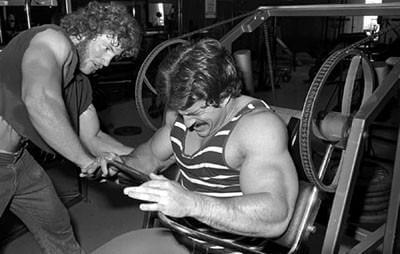Home | Articles | Book | Video | Training
Click Here to Sign Up for Your Free High Intensity Training Magazine Subscription
Mike Mentzer Machines vs Free Weights
The debate surrounding the use of machines versus free weights in strength training has been a topic of discussion for decades. With numerous opinions and conflicting advice, it can be challenging to determine the most effective approach. In this article, we will explore the perspective of renowned bodybuilder and philosopher, Mike Mentzer, on this matter. We will delve into the principles underlying his methodology and evaluate the benefits and limitations of both machines and free weights.
Mentzer's Theory of High-Intensity Training
Mike Mentzer believed in maximizing muscle stimulation with minimal time investment. He argued that traditional, high-volume training methods were inefficient and counterproductive, leading to overtraining and limited progress. Instead, Mentzer advocated for high-intensity training (HIT), which involves performing fewer exercises and sets, with each set taken to momentary muscular failure.
Understanding Machines
Machines, such as the leg press, leg extension, and lat pulldown, offer several advantages in line with Mentzer's HIT philosophy. First, they provide a controlled range of motion, reducing the risk of injury and promoting proper technique. Machines also typically feature weight stacks or resistance systems that allow for incremental adjustments, ensuring progressive overload and tailored resistance.
Targeting Specific Muscle Groups
One of the primary benefits of machines is their ability to isolate specific muscle groups effectively. By adjusting the seat, backrest, or footplate, machines can target specific muscles without engaging secondary muscles or relying on stabilizers. This level of isolation is particularly beneficial for rehabilitation, bodybuilding, or correcting muscular imbalances.
Minimizing Joint Stress
Free weights, such as barbells and dumbbells, often require significant stabilization from surrounding muscles and engage multiple joint complexes simultaneously. In contrast, machines provide a safer and more controlled environment that minimizes stress on the joints. This is particularly advantageous for individuals with preexisting joint issues or those who are new to strength training.
Personalized Resistance Profile
Another significant advantage of machines is their ability to offer a customized resistance profile. Traditional free weights provide constant resistance throughout the entire range of motion, which may not align with an individual's strength curve. Machines, on the other hand, can be designed to match the individual's strength curve, providing optimal resistance at every point in the exercise.
Variability and Versatility
While free weights promote functional movement patterns and enhance overall strength, machines can offer a vast array of exercise variations and angles, allowing for versatile training options. Additionally, many machines provide specific features such as adjustable cams, pins, and attachments, enabling individuals to target specific muscles or modify exercises to suit their unique needs.
The Case for Free Weights
Although Mentzer favored machines, he recognized the value of free weights in certain contexts. The use of free weights demands greater stability and coordination, creating a more holistic workout that engages multiple muscle groups simultaneously. Free weights also activate smaller stabilizing muscles, promoting better proprioception and overall balance.
Enhanced Muscle Fiber Activation
Research suggests that free weights may offer an advantage when it comes to muscle fiber activation. The requirement to stabilize the weight activates additional muscle fibers, leading to greater overall muscle recruitment compared to machines. This can be particularly beneficial for athletes participating in sports that demand functional movement patterns.
Core Engagement
Free weight exercises, such as squats and deadlifts, engage the core muscles to a greater extent than most machine exercises. The need to stabilize the weight activates the deep muscles of the core, including the transverse abdominis and multifidus, promoting core strength and stability.
Conclusion
In conclusion, the debate between machines and free weights in strength training is multifaceted. While Mentzer's emphasis on intensity, efficiency, and safety led him to favor machines over free weights, both approaches have their merits. Machines offer controlled movements, target specific muscle groups, and minimize joint stress. On the other hand, free weights promote functional movement patterns, enhance overall strength, and can activate more muscle fibers. Ultimately, the choice between machines and free weights should be based on individual goals, preferences, and considerations such as injury history or specific training requirements. Irrespective of the chosen approach, it is essential to prioritize proper form, progressive overload, and consistency to achieve optimal results in strength training.
If you have any questions about Mike Mentzer, Heavy Duty, High Intensity Training, Diet, etc. email us and we'll get back to you with an answer as soon as we can.
Click Here to Sign Up for Your Free High Intensity Training Magazine Subscription
Home | Articles | Book | Video | Training

Mike Mentzer Mr. America and Mr. Universe
